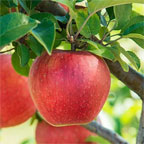- Q.Bare Root Perennials In Local Home Depot - While browsing in my local Home Depot this weekend, I noticed bare root perennials in boxes for sale. I was ...
- Q.How Do I Kill Off Lily Of The Valley Flowers? - Dug them out last year and the root system was crazy, but they're back. What can I use to get ...
- Q.Lily Of The Valley - Are there any ways to get rid of lily of the valley. I have dug mine up repeatedly and it ...
- Q.What Can Grow With Lily Of The Valley - The Lily of the valley tubers secrete a natural herbicide that kills most plants. What can grow amongst the tubers ...
- Q.About Lima Beans - I recently bought some various lima beans from America. They were confiscated by customs. Why? Can I buy lima beans ...
- Q.Harvesting Large Lima Beans - Do I leave the plants in the ground and wait for the pods to dry, do I pull the plants and pick ...
- Q.Shade Growing Ground Cover - Have you heard of a ground cover called seapack? Maybe I am not spelling it right but it is a ...
Q.Bare Root Perennials in Local Home Depot
While browsing in my local Home Depot this weekend, I noticed bare root perennials in boxes for sale. I was tempted to purchase lily-of-the-valley, day lilies, and ferns. I noticed that some of the plants had sprouted in the plastic bags. I live in southwest PA. The temperature was 22 degrees this morning, too cold to plant the sprouted plants. Could I purchase these plants, plant them indoors, and later transplant? I notice that my hostas, day lilies, and some other plants are just getting green. Are these plants worth purchasing?
- A.
You can purchase them and either plant right away, if it's feasible, or store them. This article should help with that: https://www.gardeningknowhow.com/ornamental/bulbs/bgen/how-to-store-bulbs-that-have-sprouted.htm
Was this answer useful?00
Q.How Do I Kill Off Lily of the Valley Flowers?
Dug them out last year and the root system was crazy, but they're back. What can I use to get rid of them without hurting other plants around them?
- A.
It can be pretty hard to get rid of. Hand digging is about the least damaging to the plants method of control.
You can try cutting the plants off at the soil line and then immediately painting the cut on each plant with undiluted Roundup. The plant will pull the Roundup into the root system and this will help to kill the roots.
Pouring boiling water over the area will also help. But, boiling water is like Roundup in that it will kill any vegetation it comes in contact with.
Was this answer useful?00 Q.Lily of the Valley
Are there any ways to get rid of lily of the valley. I have dug mine up repeatedly and it always comes back with a vengence.
- A.
This article should help: https://www.gardeningknowhow.com/ornamental/bulbs/lily-of-the-valley/lily-of-the-valley-control.htm
Was this answer useful?00 Q.What Can Grow With Lily of the Valley
The Lily of the valley tubers secrete a natural herbicide that kills most plants. What can grow amongst the tubers that will survive? Looking for companion plants for Lily of the Valley.
- A.
Good companions for lily of the valley include a variety of spring bulbs, hosta, perwinkle, anemone, forsythia, ivy, ferns, winter jasmine, cotoneaster and weigela.
Was this answer useful?00 Q.About Lima Beans
I recently bought some various lima beans from America. They were confiscated by customs. Why? Can I buy lima beans or similar large beans in Australia please?
Regards,
Stuart- A.
Many countries have laws regarding the import of organic based products. These laws are designed to prevent plant diseases and invasive species from crossing international borders.
If you are going to buy seeds from overseas, check to see if the company has been authorized to sell to your country. Basically, they would have gone through a process where they are certified as being free of diseases and species that could be a problem in your country.
You should also be able to find a company in your country that supplies these kinds of seeds. If you are unable to find one, try looking for other like minded gardeners who would like to trade seeds with you or check on places like eBay for small suppliers of these kinds of seeds.
Was this answer useful?00 Q.Harvesting Large Lima Beans
Do I leave the plants in the ground and wait for the pods to dry, do I pull the plants and pick the pods and let dry, or do I shell the pods and just dry the beans?
- A.
Here is an article that you may find helpful: https://www.gardeningknowhow.com/edible/vegetables/beans/harvesting-beans-when-do-you-pick-beans.htm
Was this answer useful?00 Q.Shade Growing Ground Cover
Have you heard of a ground cover called seapack? Maybe I am not spelling it right but it is a gound cover that is grown in shade and a friend said it is very lucious and green looking. And I am having trouble with the squirrels digging up my newly planted lily of the valley and I don't know what to do about them. I can't get the lily of the valley to grow. Well, they are not in the ground long enough to get started. HELP!
- A.
I have not heard of seapack before. But here is a directory and article of some common ground covers that might help you locate one that you like: https://urbanext.illinois.edu/groundcovers/directory/index.cfm, https://www.gardeningknowhow.com/special/shade/ground-covers-for-shade.htm You can try spreading bloodmeal among the newly planted lily of the valley. This sometimes will keep the squirrels away. Another method is to use chicken wire to fashion cages over and below the plants. The ones in the ground can stay there as the roots will easily grow through the holes and the ones above the ground can be removed once the plants are established and less of a taret to the squirrels.
Was this answer useful?00



